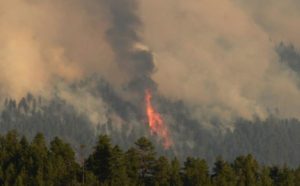It’s no surprise to snow and outdoor enthusiasts that Colorado had a drier and warmer winter than usual. The recently released March 2018 Drought Update confirms that the state is currently experiencing the third lowest snowpack on record. Only 2002 and 1981 were drier.
Extreme drought now covers most of southwestern Colorado, the San Luis Valley and southeastern Colorado. Western Slope water providers with limited storage are concerned about the demand this season and are considering possible restrictions, while Front Range water providers are developing conservation messaging.
Water is considered one of the most valuable resources in the western United States. When water is in short supply, everyone in Colorado has to learn to make adjustments. People in urban areas are encouraged to be water frugal in both personal and landscapes uses.
Farmers and ranchers make adjustments to their production strategies. Land management officials forge lease and activity arrangements that best protect the health of the public land. These plans are aimed at decreasing economic loss and maintaining precious range and soil health.

In dry years, increased concern for wildfires is prevalent. A red flag advisory is issued by the U.S. National Weather Service when conditions are ideal for wildland fire combustion and rapid spread. These conditions are drought, very low humidity and high or erratic winds (which may include lightning).
The Red Flag Warning will trigger staffing and equipment changes in agencies responsible for response. For the public, a Red Flag Warning cautions citizens to avoid activities that might set off fire and be prepared to evacuate if a fire does begin.
In rural communities, local fires are initially fought by volunteer firefighters, seasonally employed wildland fire fighters, forest service personnel, farmers and ranchers. Damage to acres of productive land, crops, and animals rarely garner the national attention that threats to public safety of large numbers of people do. Yet, already in 2018, multiple large grass and wildland fires have been reported in Colorado, Oklahoma, northern Texas and Kansas.
Agriculture disaster training and emergency planning
To assist the areas of Colorado most affected by the drought, and at risk for subsequent fire and flood, three free workshops are being offered by Colorado State University Extension, in cooperation with Colorado Department of Agriculture and Scott Cotton of University of Wyoming Extension. The programs will be held at Dove Creek in Dolores County, Salida in Chaffee County and Las Animas in Bent County.
These one-day training will prepare producers, land owners, county officials, first responders, Extension agents and other citizens to collaborate on emergency response in their area. The more prepared community members are for these unfortunate events, the more successfully they can respond.
The programs include:
- Local disaster issues
- Drought preparedness and response
- Fire mitigation
- Livestock transport accidents
- Animal ID and disease related to disasters
- FEMA training on livestock evacuation (fire/flood)
Courses are both FEMA and Peace Officer (P.O.S.T.) Certified
The dates for the programs are:
Dolores County (April 11)
Chaffee County (April 25)
Bent County (May 15)
County Extension offices will have more information about the programs. Additional information is available below.
Ragan Adams, DVM, is CSU Veterinary Extension Specialist